1.7 Where the Russians stopped the Swedes: Battle of the Neva (1240)
Alexandr Filyushkin
Edited by Jörg Hackmann and Juhan Kreem
Swedes and Russians have had a long history of conflict in the Baltic Sea Region, which stopped only when Sweden renounced its imperial aspirations after the loss of Finland in 1809 and attempted to make re-conquests within its own borders, as Esaias Tegnér claimed, i.e. developing the Swedish nation internally and peacefully instead of waging war with its neighbours. Here we look at the events in the 13th century: What happened at the mouth of the Izhora river on 15th of July, 1240?
Throughout 7th and the early 8th centuries, the opposition grew between Russian Novgorod and the Swedish Kingdom in the struggle over the land of Karelia, Neva and the Baltic. Swedes fought crusades here, Rus' fought for baptizing peoples of Karelia. Since there were no recognised borders in these lands, and fortresses were scarce, the parties made attempts to secure land rights by means of campaigns and long-range raids. Here, Novgorod and Sweden had a dispute over Izhorskaya land (lands along the Neva river, which flows into the Baltic Sea).
Direct evidence on the Battle of the Neva is available from Russian sources exclusively. Swedish sources only offer vague information about the campaign against Russia in 1240; no details are given.
According to the Russian chronicles, the purpose of the Swedes' crusade in 1240 was the capture of the key Russian fortress in the region, Ladoga, as well as the shores of the Neva river, which would enable Sweden to control access to the Baltic from the river system of the Russian Plain, across the Volkhov river and the lake of Ladoga. The ultimate goal could have been to conquer the whole Novgorod land.
The campaign involved Swedes and Suomi (sum'), a Finnish tribe. The troops were led by Ulf Fase, the governor (jarl) of Sweden in 1240. The army marched off from Stockholm, crossed the Baltic Sea, came to Turku and moved towards the mouth of the Neva river. The size of the Swedish troop is not known precisely. Historians believe that the likely figure is a few hundred people. According to the chronicles, Alexander Nevsky’s army amounted to about 1,300 soldiers who took part in the Battle of the Neva.
The movement of Swedish naval vessels was spotted by the Russian guards at the mouth of the Neva river. A message was sent to Prince Alexander of Novgorod right away. He immediately marched out to meet the enemy, drifted along the Izhora river, and on 15th of July, 1240 attacked the camp of the Swedes, who had stopped to rest at the mouth of the Izhora river, at the confluence with the Neva. The battle lasted for several hours; the Swedes suffered losses, boarded their ships and retreated. The Russian army won the battle, and thus the Swedish campaign was disrupted. It was an unqualified victory. Indeed, the Swedes did not launch any further attacks on the land of Novgorod until 1256. Prince Alexander gained a reputation of being a talented commander and earned the nickname "Nevsky".
Today, at the mouth of the Izhory, a small river, we witness an unusual concentration of monuments. An area of 300 by 300 meters hosts 4 monuments and a museum. Established at different times, they are devoted to one and the same event, which is mentioned in every Russian history textbook. It is here that one of the main Russian "sites of commemoration" is located. On 15th of July, 1240 the army under the command of Prince Alexander of Novgorod defeated the Swedish troops. The young prince was given the name of Alexander Nevsky and became a symbolic figure in Russian history.
- A.D. 1240. A. M. 6748. The Svei came in great strength with the Murman, Sum, and Yem people in very many ships. The Svei came with their Knyaz and with their bishops, and halted in the Neva at the mouth of the Izhera, wishing to take possession of Ladoga, or in one word, of Novgorod, and of the whole Novgorod province. But again the most kind and merciful God, lover of men, preserved and protected us from the foreigners since they laboured in vain without the command of God. For the news came to Novgorod that the Svei were going towards Ladoga, and Knyaz Alexander with the men of Novgorod and of Ladoga did not delay at all; he went against them and defeated them by the power of St Sophia and the prayers of our Sovereign Lady the Holy Mother of God and eternally Virgin Mary on the 15th day of July, the Commemoration Day of Saints Kyurik and Ulita, and the Day of the Veche of the 630 Holy Fathers of Khalkidon. And there was a great slaughter of Svei. Their Voyevoda, by name Spiridon, was killed, and some thought that their bishop was also killed there; and a very great number of them fell. And having loaded two vessels with their best men got, away first to sea; and the rest of them having dug a pit they threw into it without number; and many others were wounded; and the same night without waiting for the light of Monday they went away in shame. And of the men of Novgorod and Ladoga there fell Kostyantin Lugotinits, Gyuryata Pineshchinich, Namest, Drochilo son of Nezdilo the tanner, twenty men in all with the men of Ladoga, or less, God knows. And Knyaz Alexander with the men of Novgorod and of Ladoga all came back in health to their own country, preserved by God and St Sophia, and through the prayers of all the saints.
- - Novgorod First Chronicle from the 14th century. Translation from: The Chronicle of Novgorod, 1016—1471.Translated by R. Michell and N. Forbes, with an introduction by C. R. Beazley and an account of the text by A. A. Shakhmatov. L., 1914. Pp. 84-85.
- Of the battle and victory on the Neva thanks to the apparition of the Holy martyrs Boris and Gleb and the aid of god's angels […]. The king of a country of Roman faith which lay in the north was filled with envy and hatred, and he waxed arrogant in his mind; when the right time came – and he knew that Batu was then ravaging Russian lands on all sides – the king, on his part, hoped to conquer all that remained of Russia. And in his pride he spoke thus: "I will go and seize Novgorod the Great and all other cities, and all the Slavs will I reduce to slavery. And I will overcome Grand Prince Aleksandr himself, and take him alive with my hands".
- And he assembled many men, and his Masters and Bishops, and Swedes and Murmans, and Suomi and lam, and filled many ships with his troops. And he set out in great strength, breathing war; and crossed the sea. And he entered the Neva River, drunk with madness, wishing to seize Ladoga, and Novgorod the Great, and all Novgorodian lands as far as Valaam […] In vain did the fools strive contrary to God's will: for the report that Swedes were on their way to Ladoga came before their arrival. And they sent their envoys to Aleksandr Iaroslavich to say this: "Withstand me if you can; I have already come to you, and I will capture you, and you shall be my slave, and so shall your sons."
- As Prince Aleksandr Iaroslavich heard these words, his soul was aflame. And he entered the Church of Hagia Sophia and knelt before the holy altar, and with tears in his eyes prayed to the Lord our God, and the Most Pure Mother of God, to grand him assistance. And then he said: "O Lord our God, Thou who hast commanded that none should seek his neighbor's possessions, judge between him and me, and forbid him to seek his neighbor's possessions." […]
- And so, hastening still more, he [Prince Aleksandr] encountered the enemy in the sixth hour of the morning. And there was a great battle with the Romans, and infinite numbers of them were slain. And the Prince set his seal, with a sharp sword, on the face of the king himself. And here, too, six men of valor who battled gallantly by his side distinguished themselves among the troop of Grand Prince Aleksandr.
- The first was named Gavrilo Oleksich. This one forced his way to a snäcka [a type of boat], and saw the king's son, supported on either side, being run up on board. And he rode after them up the plank, right into the ship itself. And they were on deck before him, and turning upon him, threw him off the plank, mounted as he was, into the sea. But by God's will he came up uninjured and went into battle again, and fought gallantly with the commander himself in the midst of his troops. And here was killed their commander Spiridon, and also their bishop.
- The second was named Sbyslav Iakunovich, a man of Novgorod. This one threw himself into battle again and again, having no weapon but a single axe. He had no fear in his heart. Many fell from his hand; and all were amazed at his strength and courage.
- The third, Iakov of Polotsk, was the Prince's Master of the Hunt. He cut through the enemy ranks with his sword, and fought bravely. And the Prince praised him.
- The fourth was a Novgorodian called Misha. This one, fighting on foot, attacked the Romans, warships at the head of his men, and destroyed three of them.
- The fifth was of the Prince's junior troop, a certain Savva. This one, dashing into the king's great gold-roofed tent, cut down the pillar, and the tent collapsed. And the troops of Grand Prince Aleksandr Iaroslavich, seeing the tent fall, rejoiced.
- The sixth was Ratmir, a servant. This one fought on foot. And multitudes of Romans fell on him on all sides, and he sank under many wounds, and so died. […]
- And there happened at that time a wondrous miracle, as in the days of antiquity, during the reign of King Hezekiah, when Sennacherib, King of Assyria, waged war against Jerusalem, wishing to capture the holy city. And suddenly the angel of the Lord went forth, and stew a hundred and eighty-five thousand in the host of the Assyrians. And when men arose in the morning, they found only the bodies of the dead. Thus was it too after the victory of Grand Prince Aleksandr Iaroslavich; when he vanquished the king, great multitudes struck down by God's angels were found dead on the opposite bank of the Izhora River, where the troops of Grand Prince Aleksandr Iaroslavich had not been; even there lay many bodies of the slain.
- And the remainder of the army took to shameful flight. And they cast the dead bodies of their commanders into three big ships, and sank them in Lake Nevo.
- […]
- - Russian Illuminated Chronicle from the 16th century. Translation form the site: http://www.goldschp.net/SIG/nevskii/nev1.html
There are no Swedish sources which describe the battle. There is only vague information about Swedish attacks on Karelia and the Neva region. The site of the battle (where the Izhora River flows into the Neva River) was repeatedly built with various structures. In the 18th to 20th centuries, there were a port, bridges and roads. Thus, no trace of the 13th century battle can be found.
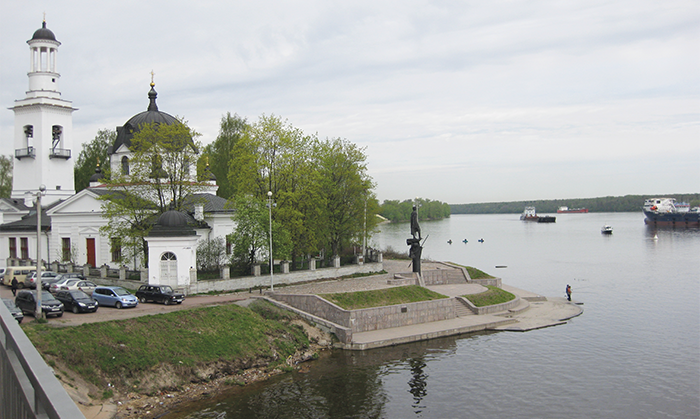
In the 13th century, it was one battle among many. But its significance for Russian history became clear over time. Glorification began in the 18th century, when Russia was at war with Sweden over the Baltic (the Great Northern War 1700-1721). In the 19th and 20th centuries, it was rhymed with the struggle of the Russian Empire for the Baltic against the Germanic world, especially during World War II. The site of the Battle of the Neva became the place of memory in the 18th to 20th centuries.
St Alexander Nevsky: the first monument to mark the site of commemoration was a temple monument
In July 1710, while inspecting the new neighbourhoods of St Petersburg, the capital of the Russian Empire, Tsar Peter I ordered a monastery to be established at the confluence of the Neva and Chernaya rivers in honour of Prince Alexander Nevsky. The tsar was convinced that the monastery was founded on the actual site of the Battle of the Neva which was fought on July 15, 1240 against the Swedish army. As a result of the battle in the thirteenth century, the Sweden's expansion in the Baltic was halted, and Prince Alexander was given the name of "Nevsky". Since in 1700-1721 Russia was at war with Sweden for the Baltic coast, the historical parallels were obvious. Prince Alexander Nevsky became the patron saint of the new capital, St Petersburg.
However, the tsar was mistaken, since the actual site of the battle of 1240 was downstream on the Neva river, over 15 km from Alexander Nevsky Monastery. Today the monastery, now bearing the name Alexander Nevsky Lavra, is located at the end of Nevsky Prospekt in the centre of St Petersburg. The exact site of the battle can be found at the mouth of the Izhora River, a tributary of the Neva River. In 1711-1712 a wooden church was built here, consecrated in honour of St Alexander Nevsky, by order of Peter the Great, who had found out that he had been mistaken. According to the legend, it was here, in front of the church, that in 1724 Tsar Peter welcomed St Alexander Nevsky's relics which were transported from the city of Vladimir to St Petersburg.
The first wooden memorial church burned in 1726. It was restored in 1730 only to burn again in 1797. In 1798-1799, a stone memorial church was built to commemorate the Battle of the Neva, and this has been preserved to the present day. It is assumed that the architects of the church were P. and V. Neyolovs. The church was reconstructed in 1820-1823, 1835-1836, and then again in 1871-1875. In 1934, it was closed by the Communists and used as a warehouse. The church was severely damaged during World War II. In 1942, the bell tower was blown up and, in 1962, the church dome collapsed due to the damage.
In 1986 a proposal was put forward to place a commemorative obelisk on the church ruins in honour of the Battle of the Neva. Then, however, a major project was launched to restore the memorial church. "Neva Battle", a society of volunteers chaired by G. Trubnikov, played a large part in promoting this idea. In 1987-1995, the church was restored (major works performed by "Lenoblrestavratsiya" company) and handed over to Orthodox Christians.
The Church of St Alexander Nevsky is situated on the left bank of the Izhora River at the confluence with the Neva River. It has two chapels, the Northern one consecrated to honour St Nicholas; the Southern one consecrated to honour the beheading of St John the Baptist.
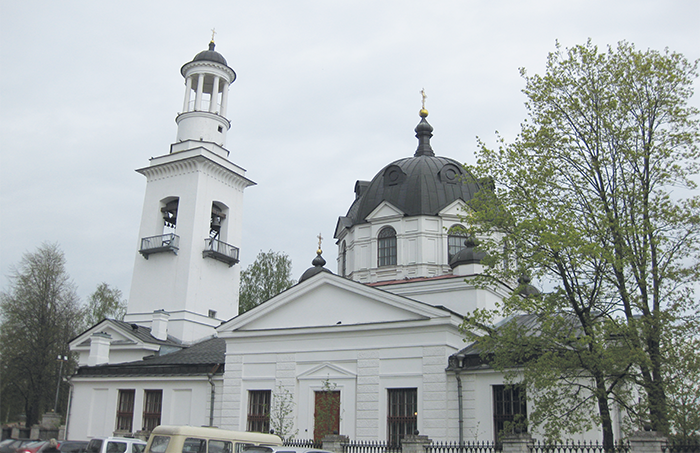
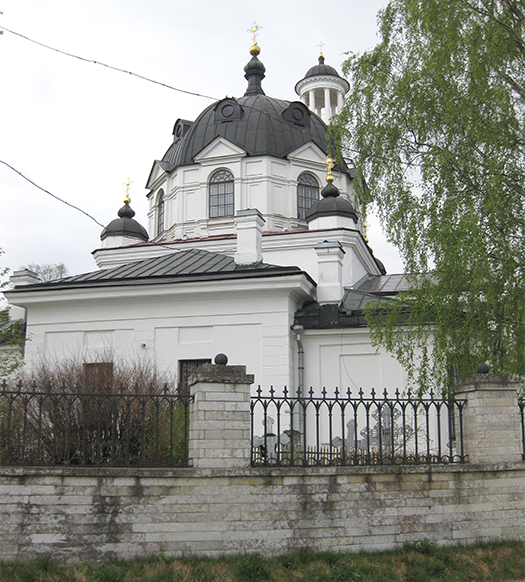
Soviet Monument of Military Glory
In 1958 a 1.5-meter stele of polished stone was put up by military and veterans’ associations ("military societies") on the right bank of the Izhora River, about 200-300m from the mouth, to honor the 250th anniversary of Leningrad (1703-1953). The inscription on the stone reads:
- ON JULY 15TH, 1240 THE BATTLE OCCURRED HERE IN WHICH THE RUSSIAN ARMY UNDER THE COMMAND OF ALEXANDER NEVSKY THOROUGHLY AND CONVINCINGLY DEFEATED THE NUMERICALLY SUPERIOR ENEMY FORCES WHICH HAD INVADED OUR MOTHERLAND. ERECTED BY THE CITY MILITARY COMMUNITY TO COMMEMORATE THE 250TH ANNIVERSARY OF LENINGRAD.
The monument is designed in a modest and rigid military style characteristic to military memorials erected on the territory of the USSR in the 1950s. Due to its appearance, it certainly drew parallels between the battle of the thirteenth century and the recently finished Great Patriotic War. The main idea it symbolised was holding off the attack of foreign invaders, the external aggression.
The unique feature of the monument is that it was positioned as a monument on the site of the Battle of the Neva of 15th of July, 1240. The exact site of the battle is unknown, yet it is obvious that it occurred near the mouth of the Izhora River where the camp of the Swedish troops was located that was attacked by the soldiers of Prince Alexander. Historians still argue whether the battle occurred on the right or the left bank of the Izhora River. The monument is located on the right bank, and the memorial church is on the left bank.
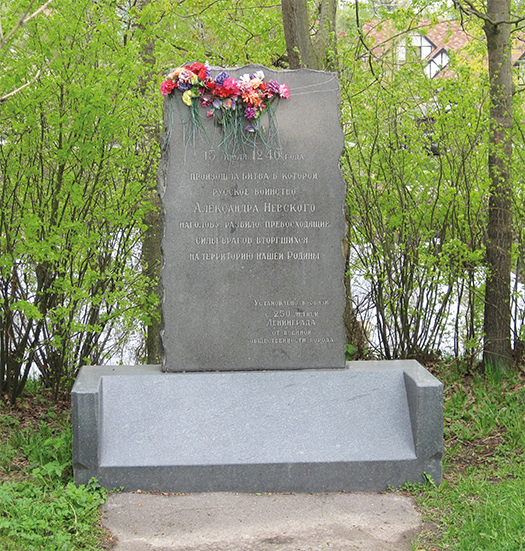
Prince Alexander victory is a sign of God's protection
Many legends saying that a great victory was won with God's help are associated with the Battle of the Neva. Prince Alexander Nevsky was canonised in 1547. He is not only one of the most famous Russian military leaders, but also one of the most revered saints. The latter aspect has come to the fore in the post-Soviet era. In 2002, a group of statues called "A memorial chapel on the site of God's help on the day of the Battle of the Neva" was put up in the cemetery near the church of St Alexander Nevsky. A half-figure portrait of Alexander Nevsky is located in the sculpture frame of the Orthodox chapel. A. V. Ostapenko was the benefactor of the project, A. A. Seleznyev initiated the project, and sculptors G. Kozenyuk and A. A. Palmin, architects V. L. Chulkevich and V.E. Zhukov sculptured and designed the monument.
The monument is primarily a symbol of Christianity, not military force, and Christian symbolism is further underscored by the monument's location in the memorial area - the church cemetery. The Battle of the Neva here acts as a manifestation of divine intervention, a symbol of God's protection of Russia (the inscription on the memorial chapel dome reads: "God is not in force, but in truth").

Prince Alexander defeated the Swedes and repelled the aggression of the West against Russia
In 2003, a monument to Alexander Nevsky by sculptor V. E. Gorevoy and architect V. A. Popov was put up on the left headland of the mouth of the Izhora river, opposite the church of St Alexander Nevsky. The monument is a standing sculpture in bronze on a high pedestal (the total height of the monument is 10 meters; the weight is 6 tons). Prince Alexander is depicted a warrior in armour, trampling weapons and armor of defeated enemies under his feet. The armour reveals Western European elements, like a Topfhelm-type helmet which became not so much a symbol of the Swedes, but of the Teutonic Knights due to the films made on the topic. Thus, the image of Alexander Nevsky as a ruler who repelled the attack of the West on Rus' comes to the fore.
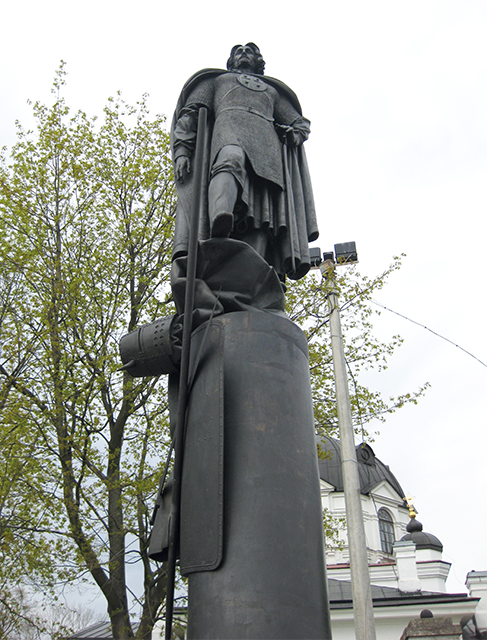
Museum as a capture of the historical myth
In 2009, a museum with a diorama "The Battle of the Neva" was established on the headland of the Izhora River and on the bank of the Neva River. The main exhibit is a diorama depicting the battle, made by an artist I. S. Zhebrovsky; modern armour models are also exhibited. The content and spirit of the museum visualises the canonical version of "The Life of Alexander Nevsky", thus reproducing the legendary events of 1240. It combines all of the three previous aspects: the Battle of the Neva as the symbol of repelling the aggression of foreign invaders, the church aspect, and Alexander Nevsky as a warrior who defeated the West. It should be noted that the museum was opened at the initiative of the public, residents of the village of Ust-Izhora, enthusiasts and patriots of their "small motherland", so it is largely popular.
How and when did the Battle of the Neva become the Russian historical "site of commemoration"?
For contemporaries, the battle of the Neva of 1240 was primarily a biographical highlight of Prince Alexander Nevsky, his outstanding military feat. No wonder its most detailed description is preserved in the Life of the Prince, compiled around the 1280s. It was believed that in the thirteenth century, the battle halted the Swedish expansion in the Neva river basin and Izhorskaya land. In Swedish history, the battle of the Neva plays a much smaller role, and it is not mentioned in Western chronicles. It was not of any interest for Swedish historiography of the nineteenth and twentieth century.
The Prince's reputation of a defender of Orthodoxy and of all of Russia was developing gradually. The warrior prince was canonised only in 1547. Since the time of Tsar Peter I (1682-1721), the role of Alexander Nevsky as a historical precursor of Peter the Great in his struggle for the Baltic Sea has come to the fore. In this context, the demand for a historical image of the Neva battle has grown year by year and the story of the battle has taken on various symbolic meanings, like confronting the Western aggression, protecting Orthodoxy from the Catholic expansion, defending the Neva and Baltic shores, and the triumph of Russia in the cultural and civilizational confrontation with Europe.
Monuments concentrated in the village of Ust-Izhora near the site of the Battle of the Neva, reflect all symbolic aspects that are of importance for Russian history. It is noteworthy that there is an accumulation of these aspects, and that not a single one of them has been discarded. The reputation of the Battle of the Neva has been further developed with the help of modern technologies. Thus, in 2008, a film was launched in Russia, Alexander. The Battle of the Neva, directed by Igor Kalenov, in which the state ideology, scientific historiography and people's recollection of the event all match; there are no contradictions between them.
Questions for reflection and discussion
- How has the image of Alexander Nevsky changed over time? Which political events have influenced this process?
- What can we infer about the lack of sources and historiography from the Swedish side?
- Have a look at the next text “Alexander Nevsky Cathedral in Tallinn”. Which similarities and differences can you find?
Further reading
- Mari Isoaho. The Image of Aleksandr Nevskiy in Medieval Russia: Warrior and Saint (The Northern World; 21). Leiden, Brill Academic Publishers, 2006.
- Yurij Krivosheev, Roman Sokolov. Aleksandr Nevskij: Epokha i pamiat’ (Alexander Nevskii. Epoch and memory). St Petersburg, Izdatel’stvo Olega Abyshko, 2018.
- Frithjof Benjamin Schenk. Aleksandr Nevskij. Heiliger – Fürst – Nationalheld. Eine Erinnerungsfigur im russischen kulturellen Gedächtnis (1263-2000) (Alexander Nevskii. Saint - Prince - National Hero. A commemorative character in Russian cultural memory). Köln, Weimar, Wien, Böhlau Verlag, 2004.